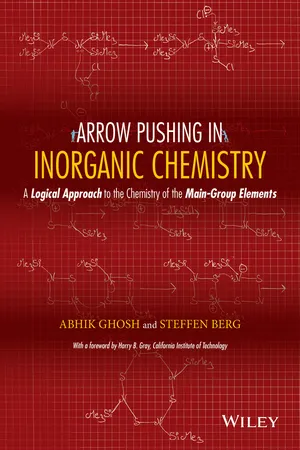
Arrow Pushing in Inorganic Chemistry
A Logical Approach to the Chemistry of the Main-Group Elements
- English
- ePUB (mobile friendly)
- Available on iOS & Android
Arrow Pushing in Inorganic Chemistry
A Logical Approach to the Chemistry of the Main-Group Elements
About this book
Involved as it is with 95% of the periodic table, inorganic chemistry is one of the foundational subjects of scientific study. Inorganic catalysts are used in crucial industrial processes and the field, to a significant extent, also forms the basis of nanotechnology. Unfortunately, the subject is not a popular one for undergraduates. This book aims to take a step to change this state of affairs by presenting a mechanistic, logical introduction to the subject.
Organic teaching places heavy emphasis on reaction mechanisms - "arrow-pushing" - and the authors of this book have found that a mechanistic approach works just as well for elementary inorganic chemistry. As opposed to listening to formal lectures or learning the material by heart, by teaching students to recognize common inorganic species as electrophiles and nucleophiles, coupled with organic-style arrow-pushing, this book serves as a gentle and stimulating introduction to inorganic chemistry, providing students with the knowledge and opportunity to solve inorganic reaction mechanisms.
• The first book to apply the arrow-pushing method to inorganic chemistry teaching
• With the reaction mechanisms approach ("arrow-pushing"), students will no longer have to rely on memorization as a device for learning this subject, but will instead have a logical foundation for this area of study
• Teaches students to recognize common inorganic species as electrophiles and nucleophiles, coupled with organic-style arrow-pushing
• Provides a degree of integration with what students learn in organic chemistry, facilitating learning of this subject
• Serves as an invaluable companion to any introductory inorganic chemistry textbook
Frequently asked questions
- Essential is ideal for learners and professionals who enjoy exploring a wide range of subjects. Access the Essential Library with 800,000+ trusted titles and best-sellers across business, personal growth, and the humanities. Includes unlimited reading time and Standard Read Aloud voice.
- Complete: Perfect for advanced learners and researchers needing full, unrestricted access. Unlock 1.4M+ books across hundreds of subjects, including academic and specialized titles. The Complete Plan also includes advanced features like Premium Read Aloud and Research Assistant.
Please note we cannot support devices running on iOS 13 and Android 7 or earlier. Learn more about using the app.
Information
Chapter 1
A Collection of Basic Concepts
In solving a problem of this sort, the grand
thing is to be able to reason backward. That is
a very useful accomplishment, and a very easy
one, but people do not practise it much. In the
everyday affairs of life it is more useful to reason
forward, and so the other comes to be neglected.

Table of contents
- Cover
- Title Page
- Copyright
- Foreword
- Preface
- Acknowledgments
- Advance praise for Arrow Pushing in Inorganic Chemistry: A Logical Approach to the Chemistry of the Main-Group Elements
- Chapter 1: A Collection of Basic Concepts
- Chapter 2: The s-Block Elements: Alkali and Alkaline Earth Metals
- Chapter 3: Group 13 Elements
- Chapter 4: Group 14 Elements
- Chapter 5A: Nitrogen
- Chapter 5B: The Heavier Pnictogens
- Chapter 6: Group 16 Elements: The Chalcogens
- Chapter 7: The Halogens
- Chapter 8: The Noble Gases
- Epilogue
- Appendix A: Inorganic Chemistry Textbooks, with a Descriptive-Inorganic Focus
- Appendix B: A Short List of Advanced Organic Chemistry Textbooks
- Index
- End User License Agreement